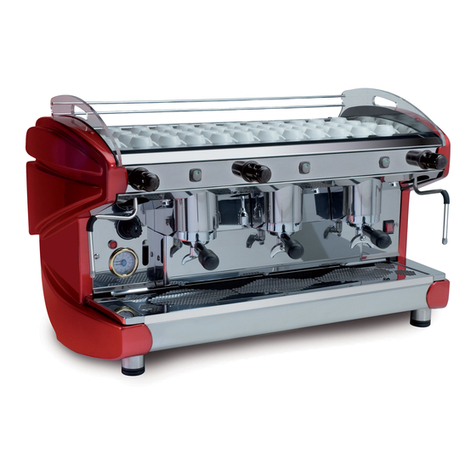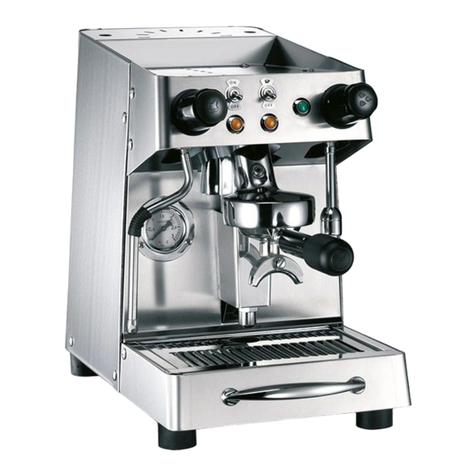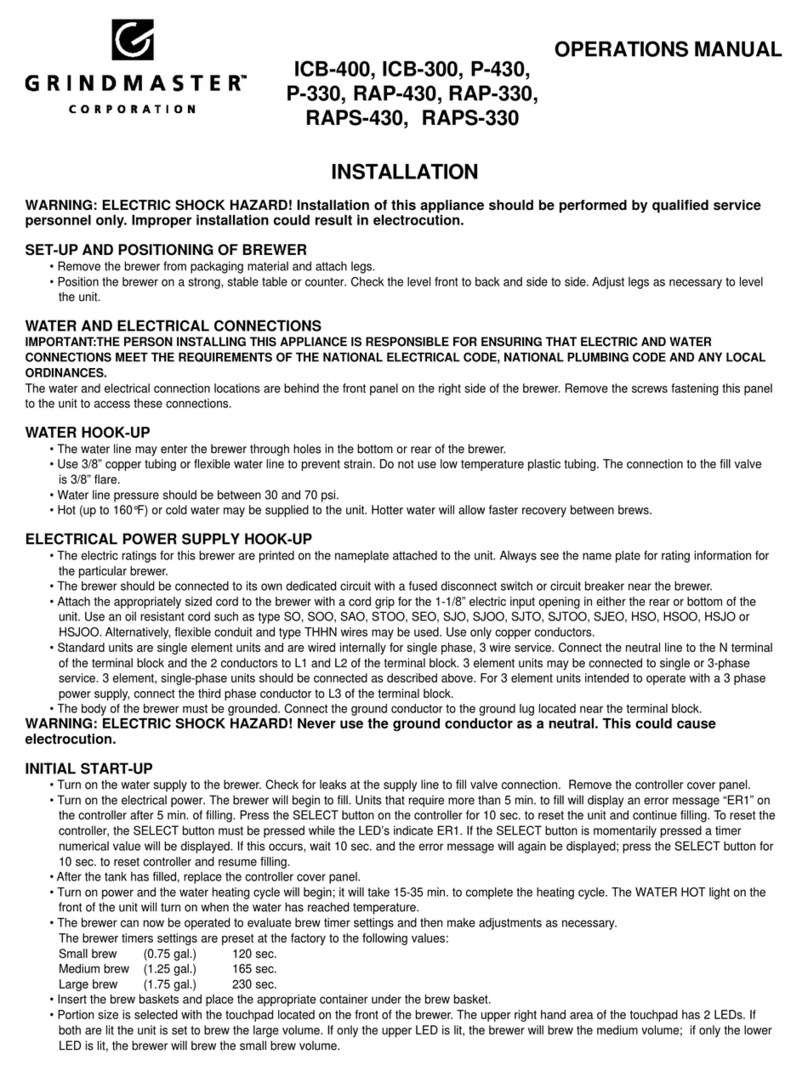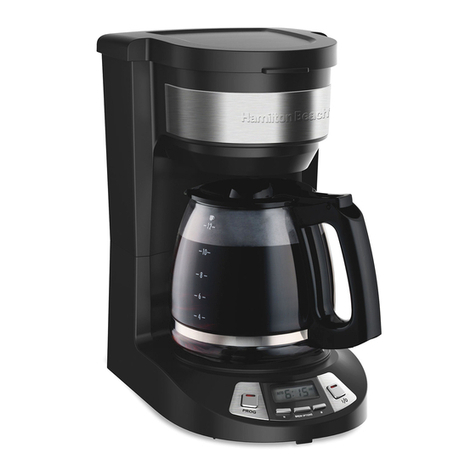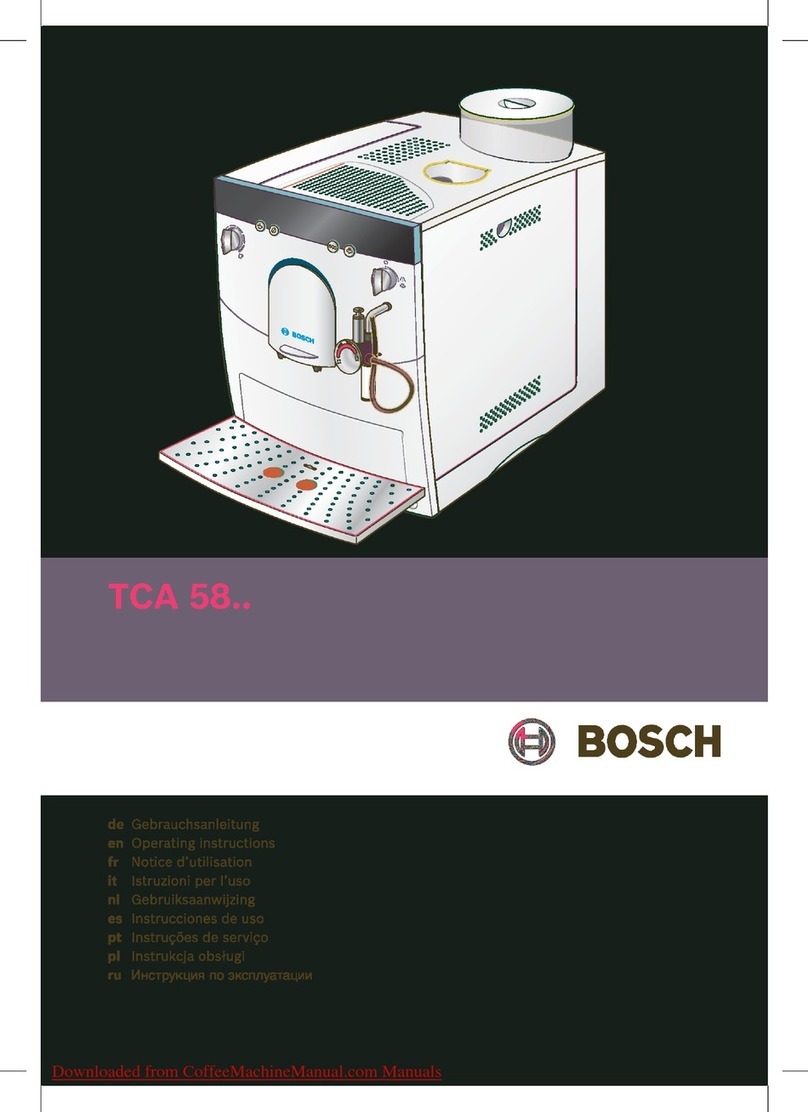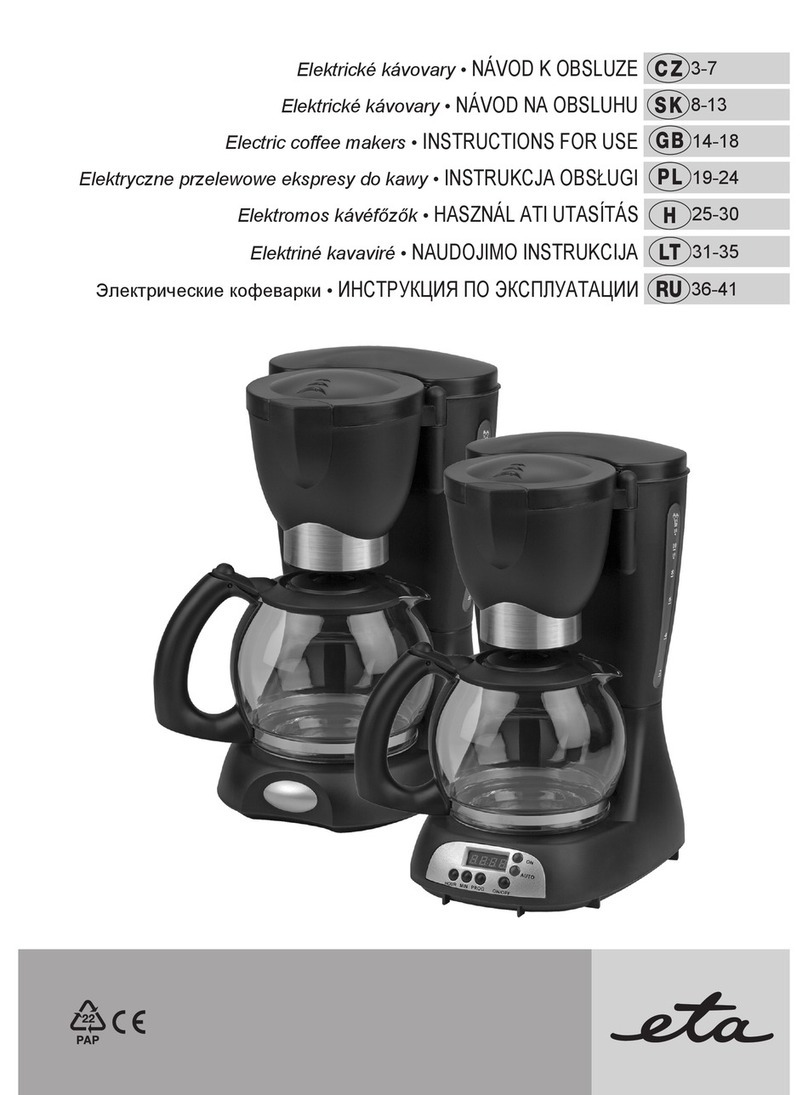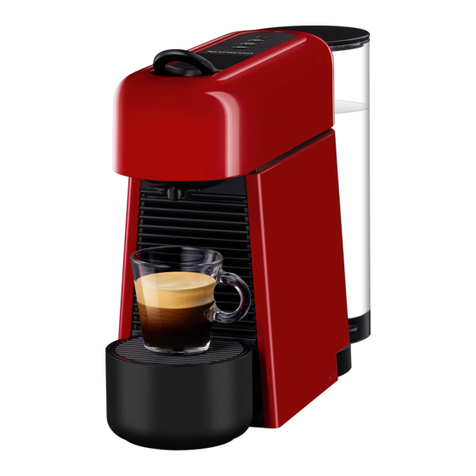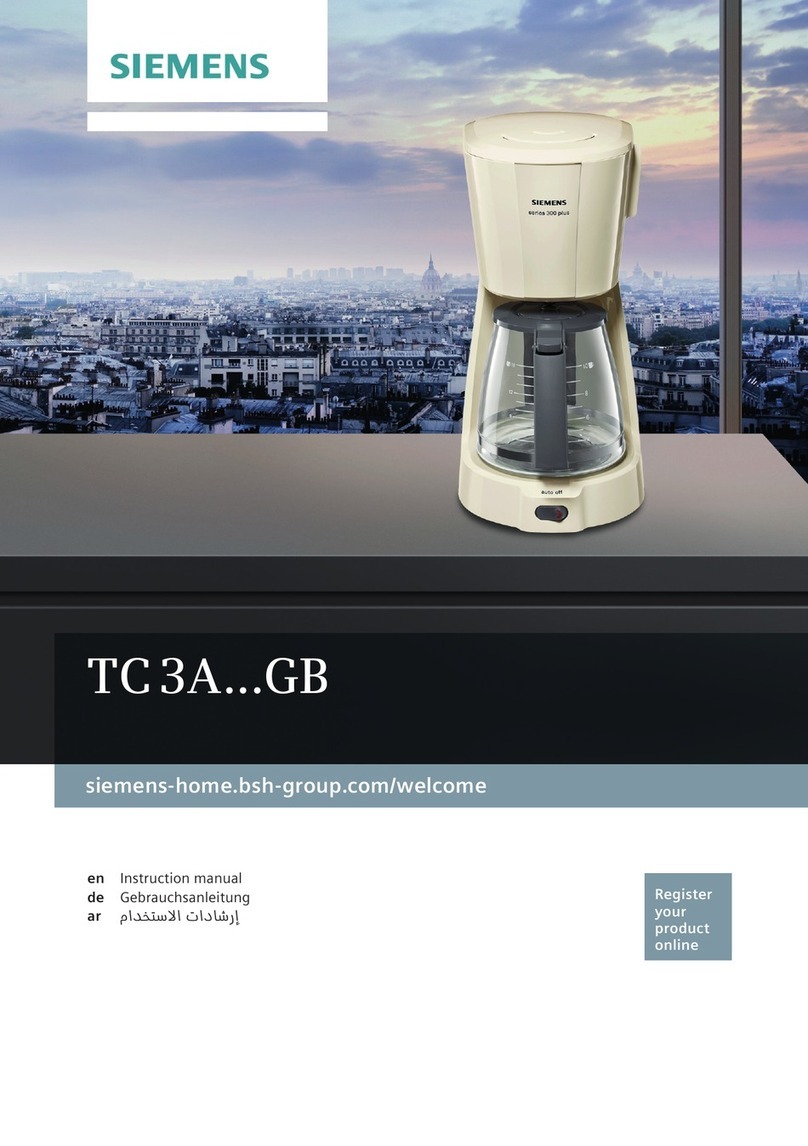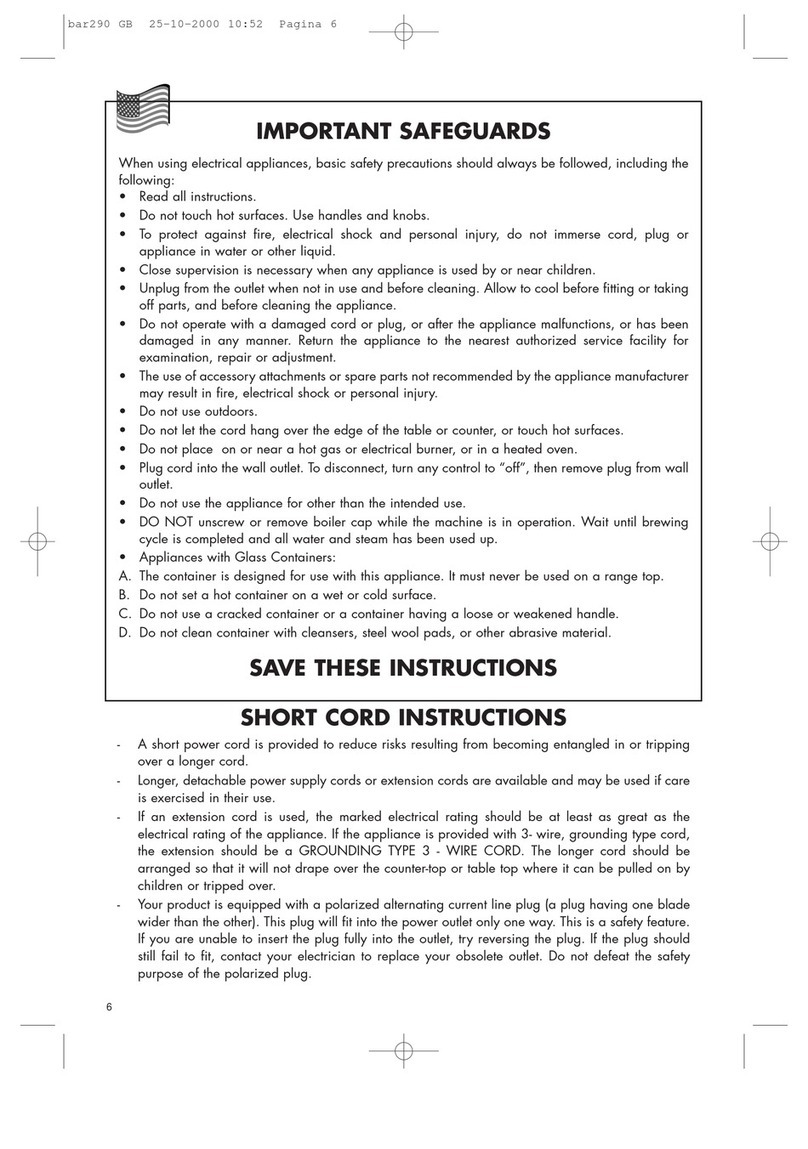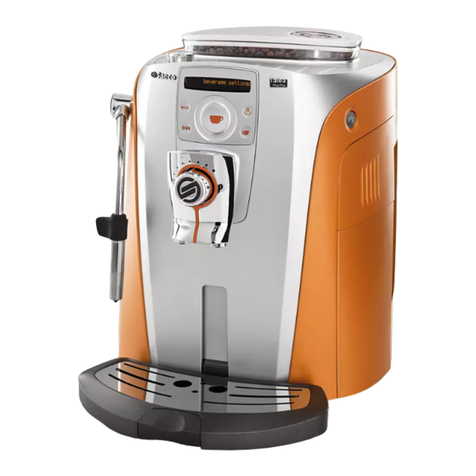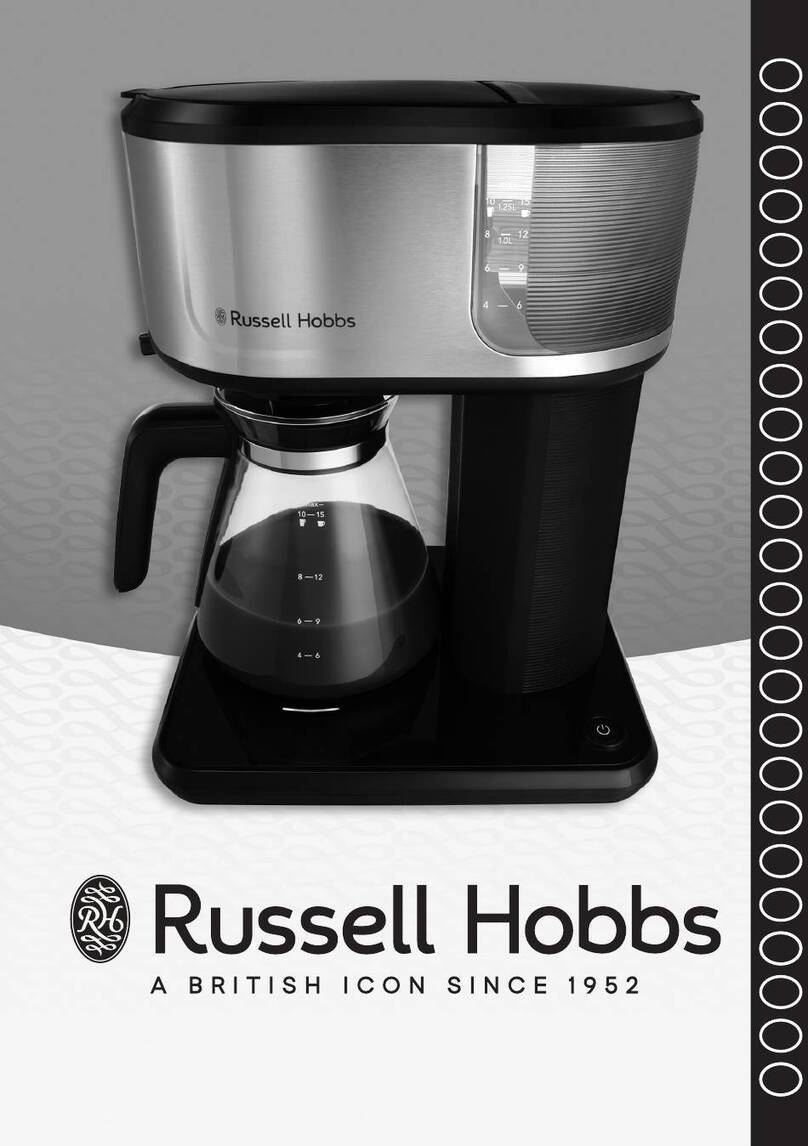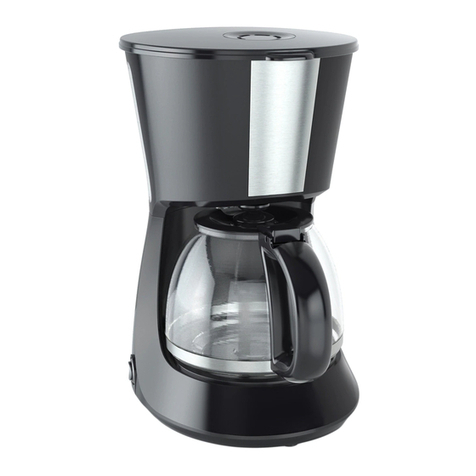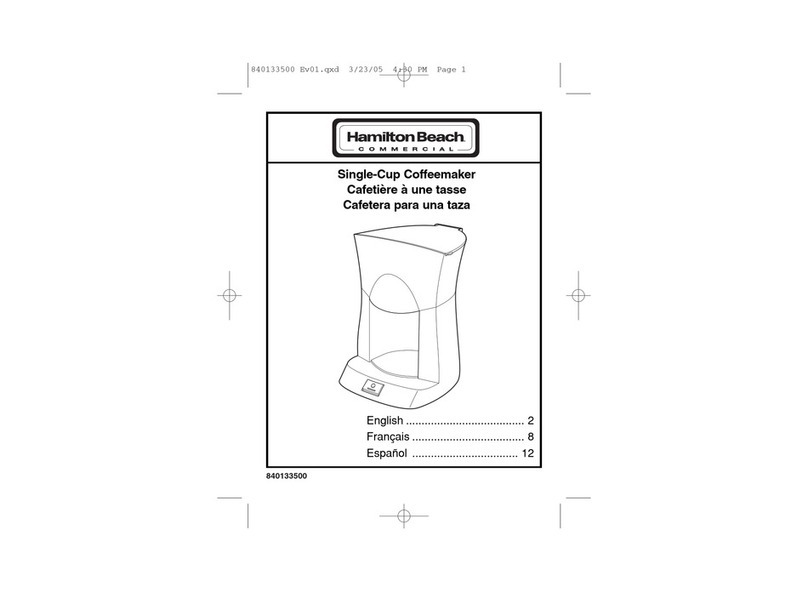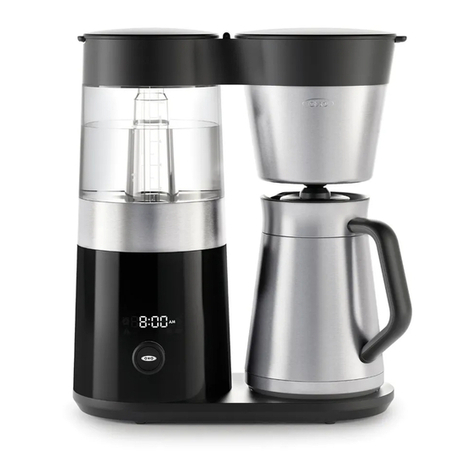B.F.C. PERFETTA User manual

PERFETTA (VP)
MANUALE DI ISTRUZIONI
INSTRUCTIONS FOR USE
BEDIENUNGSANLEITUNG
0314_Rev003

IL PRODOTTO NON PUO’ ESSERE AVVIATO ALLO SMALTI-
MENTO NEL NORMALE CICLO DI RACCOLTA RIFIUTI, MA
SMALTITO NEI CENTRI AUTORIZZATI.
THE PRODUCT CANNOT BE DISPOSED OF AS NORMAL WASTE,
BUT MUST BE TAKEN TO AN AUTHORIZED DISPOSAL CENTRE.
DAS PRODUKT DARF NICHT DEM NORMALEN ABFALLKREIS-
LAUF ZUGEFÜHRT WERDEN, SONDERN IST IN AUTORISIER-
TEN ZENTREN ZU ENTSORGEN.

INDICE /INDEX
ITALIANO ______________________________________________
Avvertenze di sicurezza
Controindicazione d’uso
Presentazione
Accessori in dotazione
Installazione
Accensione macchina
Erogazionecaè
Erogazione acqua calda
Erogazione vapore
Manutenzione
Mini addolcitore a resine
Informazioni pratiche e suggerimenti
Dichiarazione di conformità
ENGLISH ______________________________________________
Safety warnings
Precautionary measures
Introduction
Accessories supplied
Installation
Machine ignition
Coeedelivery
Hot water delivery
Steam delivery
Maintenance
Mini resin water softener
Practical information and suggestions
Declaration of conformity
DEUTSCH _____________________________________________
Sicherheitshinweise
Unzweckmäßiger Gebrauch
Einleitung
Mitgeliefertes Zubehör
Installation
Einschaltung der Maschine
Kaeezubereitung
Wasserausgabe
Dampfausgabe
Wartung
Mini-Enthärter
Praktische hinweise und Anregungen
Konformitätserklärung
1-9
10-17
18-26

1. AVVERTENZE DI SICUREZZA
◆Prima di collegare la macchina accertarsi che i dati di targa siano rispondenti a quelli della rete di
distribuzione elettrica. Collegare l’apparecchio solo a impianto e prese di corrente aventi portata
minimadi10Aedotatediecientemessaaterraesalvavita.
◆In caso di incompatibilità tra la presa e la spina dell’apparecchio, fare sostituire la presa con un’altra
ditipoadattodapersonaleprofessionalmentequalicato.
◆È vietato l’uso di adattatori, prese multiple e/o prolunghe.
◆Incasodidubbioodiincertezzafarcontrollaredapersonalequalicatol’impiantodialimentazione
elettrica, che deve rispondere ai requisiti disposti dalle normative di sicurezza vigenti, fra i quali:
-ecacemessaaterra;
-sezionedeiconduttorisucienteallapotenzadiassorbimento;
-dispositivosalvavitaeciente.
◆L’apparecchio deve essere installato solo in luoghi ove il suo impiego e il suo mantenimento sono
riservatiapersonalequalicato.
◆L’apparecchionondeveessereusatodabambiniodapersoneconcapacitàsiche,sensorialiomen-
tali ridotte o privi di esperienza e conoscenza dell’apparecchio, salvo che non siano sorvegliati o che
non siano stati opportunamente istruiti.
◆I bambini devono essere supervisionati per assicurarsi che non giochino con l’apparecchio.
◆Non esporre la macchina a intemperie o installarla in ambienti a elevata umidità come locali da
bagno ecc... Non tirare il cavo di alimentazione o l’apparecchio con mani o piedi bagnati o umidi. Non
lasciare l’apparecchio contenente acqua in ambienti a temperatura inferiore o uguale a 0°C.
La macchina non può essere installata in un ambiente all’aperto, non protetto da eventi atmosferici
o comunque con temperatura inferiore a 5 °C.
◆Prima di qualsiasi operazione di manutenzione interna, mettere l’interruttore generale nella posizione
OFF o staccare la spina dalla presa di alimentazione. A macchina elettricamente collegata, non in-
trodurre mai le mani o altri oggetti all’interno della stessa.
◆Durante la pulizia dell’apparecchio non immergerlo in acqua.
Non mettere mai l’apparecchio sotto il rubinetto per aggiungere l’acqua nel serbatoio.
◆Non ostruire le griglie di aspirazione o di dissipazione, in particolare non coprire con panni o altro il
piano scaldatazze.
◆L’apparecchio non deve essere spostato durante il funzionamento.
◆Utilizzaresoloaccessoriericambiautorizzatidalproduttore.Questosignicagaranziadisicurofun-
zionamento privo di inconvenienti.
◆Incasodiemergenza,comeprincipiod’incendio,rumorositàanomala,surriscaldamento,ecc...interve-
nireimmediatamenteastaccarel’alimentazioneelettricadirete,chiudereirubinettidelgasedell’acqua.
◆In caso di guasto e/o cattivo funzionamento dell’apparecchio, spegnerlo e non manometterlo. Per
eventualiriparazionirivolgersisolamenteaduncentroassistenzaautorizzatodalcostruttoreerichiede-
re l’utilizzo di ricambi originali. Il cavo di alimentazione di questo apparecchio non deve essere sosti-
tuitodall’utente.Seilcavoèdanneggiatoodeveesseresostituito,rivolgersiaduncentroautorizzato.
◆Conservare con cura questo libretto per ogni ulteriore consultazione. Per operazioni diverse da quelle
descritte in questo manuale, consultare il nostro centro assistenza.
Il mancato rispetto di queste avvertenze può compromettere la sicurezza
dell’apparecchio. Un’errata installazione puó causare danni a persone e
cose per i quali il costruttore non può considerarsi responsabile.
MACCHINE PER CAFFÈ ESPRESSO
MANUALE di ISTRUZIONE
1

2. CONTROINDICAZIONE D’USO
Le macchine sono destinate ad uso esclusivamente alimentare per cui é vietato l’impiego di liquidi o
materiali di altro genere che possano generare pericoli e inquinare gli erogatori.
Questoapparecchioèdestinatoall’usodomesticoeapplicazionisimili,adesempio:areediristoroper
ilpersonalediuci,negozie/oaltriambientidilavoro;aziendeagricole;utilizzodapartediclientidi
alberghi,moteloaltriambientiacarattereresidenziali;negliambientitipobedandbreakfast.
Il costruttore declina ogni responsabilità per danni a persone o cose dovuti ad uso improprio, errato o
irragionevoleeariparazionieettuatedapersonalenonqualicato.
3. PRESENTAZIONE
Questo libretto costituisce una guida rapida e semplice alla manutenzione ed uso delle macchine per
caè.Leggereattentamentequantoriportatonellesezionichecompongonoquestomanuale.
La ditta assicura, nel caso vi fossero problemi e mal funzionamenti, la sua più ampia collaborazione
tramite i suoi centri assistenza.Fate controllare almeno una volta all’anno la Vostra macchina
per caè da personale qualicato. Questacostanteattenzione,renderàlamacchinapiùeciente
e sicura. Le macchine sono state progettate e costruite nel rispetto di tutte le caratteristiche che contrad-
distinguonoletradizionalimacchinepercaèespressodabar:materialinobiliqualirameeacciaioe
componentiadabili,rendonolemacchinecostruitedalladitta,sicure,adabiliefunzionali.
L’eventuale diverso utilizzo non contemplato nelle riportate istruzioni, solleva la ditta da qualsiasi
responsabilità per eventuali danni a persone o cose.
2
Lancia acqua/vapore
Levaerogazionecaè
Portaltro
Vaschetta raccogligocce
Griglia superiore portatazze
Manometro pressione pompa (0-16 bar)
Gruppoerogatorecaè
Spia rossa vapore
Deviatore acqua/vapore
Spia rossa acqua
Spia verde resistenza
Interruttore generale ON/OFF
Spia rossa alimentazione
Manopola erogazione acqua/vapore

3
Filtro una tazza Filtro cieco
Filtro due tazze 2Mollefermaltro
Baccuccio una tazza Beccuccio due tazze
Mini addolcitore Pressino
2Portaltri
Spazzolino di pulizia
Cucchiaino dosatore
4. ACCESSORI IN DOTAZIONE

5. INSTALLAZIONE
1) Toglierel’imballo,vericandoall’istantel’integritàdellamacchinaechenonabbiasubitodanni.
2) Posizionare l’apparecchio sopra un tavolo o bancone robusto ed in piano, vicino ai punti di colle-
gamentoelettricoedidraulico.Ènecessariochelasuperciepiùaltadell’apparecchiosiaadalmeno
1,5 m da terra. La macchina deve essere installata in posizione orizzontale. L’inclinazione del piano di
appoggio non deve essere maggiore di 1°. Per garantire il normale esercizio, l’apparecchio deve essere
installato in luoghi in cui la temperatura ambiente sia compresa tra una temperatura +5°C ÷ +32°C
e l’umidità non superi il 70%. Non usare getti d’acqua, né installare in luoghi dove vengano usati getti
d’acqua. Accertarsi che la tensione della rete elettrica corrisponda a quella indicata nelle caratteristiche
tecniche.
3) Togliere la griglia superiore (12), estrarre il conte-
nitore dell’acqua posto all’interno della macchina e
sciacquarlo (Foto 1).
4) Riempire con circa 3 litri di acqua pulita la tanica,
posizionarla nuovamente nella sua sede e inserirvi i tubi
di silicone con addolcitore collegato. Richiudere la gri-
glia superiore (12) della macchina.
5) Prima della messa in funzione, l’installatore deve
vericarechelamacchinasiastatacollegatacorretta-
menteall’impiantoelettricoutilizzatoreeall’impiantoditerra,vericandol’ecienzadellaprotezione
dai contatti indiretti.
In Europa collegare alla rete elettrica il cavo omologato H05VV-F 3G 1,5 mm con spina Schuco.
In Usa-Canada collegare alla rete elettrica il cavo omologato Type SJTO, rated 3x14 AWG, 300 V,
105°C con SPINA NEMA 5x15P.
È VIETATO UTILIZZARE LA MACCHINA IN ASSENZA DI UN EFFICACE E
SICURO COLLEGAMENTO DI MESSA A TERRA.
6. ACCENSIONE MACCHINA
Prima dell’accensione della macchina, si consiglia di controllare la presenza di acqua nella
tanica posteriore posta sotto la griglia portatazze (12).
1) Azionare l’interruttore generale ON/OFF (5) ver-
so sinistra. La spia rossa di alimentazione (6) si ac-
cenderà.
2) La spia verde resistenza (4) si accende e inizia il ri-
scaldamento dell’acqua. Far uscire acqua dal gruppo
di erogazione (14) per 5 secondi in modo da elimina-
re eventuali bolle d’aria nel circuito termosifonico e
permetterne una migliore termocompensazione.
3) Attendere circa 10-15 minuti per permettere alla
macchina di raggiungere la temperatura di lavoro.
4) Lo spegnimento della spia verde (4) segnala che la macchina ha raggiunto la temperatura prestabi-
lita. La spia rossa (6) rimarrà sempre accesa per segnare la tensione di alimentazione.
NB:Incasodiprimoutilizzomantenerelamacchinaintemperatura(senzaerogareacquaecaffè)per
circa 2 ore. Si consiglia di erogare in un bricco almeno 0,5 litri di acqua per consentirne il recircolo
(vedere cap. 8). Far uscire acqua dal gruppo di erogazione (14) per 30 secondi.
5) La mancanza di acqua nella tanica posteriore arresterà tutte le funzioni elettriche e idrauliche, pur
mantenendo la spia rossa (6) accesa. Riempiendola di acqua, il micro interruttore posto sotto la tanica
riattiverà tutte le funzioni nuovamente.
4

5
6)Ilmanometro(13),postofrontalmente,rilevainognimomentolapressionedierogazionedelcaffè
(9-12 bar).
7)Lamacchinaèdotatadidispositividisicurezzacheintervengonoincasodianomalieallapressio-
ne/temperatura interna alla caldaia.
7. EROGAZIONE CAFFÈ
1)Pererogarecaèdalgruppo,dosarelagiustaquantitàdicaèMACINATOBAR(circa7grammi
pariad1cucchiainodosatore),nelportaltro(10)conuscitasingola.
2)Pressareilcaèconl’appositopressino.
3)Inserireilportaltro(10)nelgruppoerogatorecaè(14)ruotandolodasinistraadestrasinoal
bloccaggio dello stesso.
4)Posizionareunatazzasottoilportaltro(10).
5) Azionare la leva manuale (9), laterale al gruppo, verso l’alto.
6)Alraggiungimentodellaquantitàdicaèdesiderata,fermarel’erogazioneazionandolalevama-
nuale (9) verso il basso.
7)Sesidesiderafarealtricaè,togliereilportaltro(10)ruotandolodadestraasinistraevuotarei
fondidicaè.Ripeterepoileoperazionisopraelencate.
8)Perottenereduecaè,utilizzareilportaltro(10)adueusciteconduedosidelcucchiainodosatore.
9)Acquistandol’appositoadattatore(option),èpossibileutilizzareanchelacialdadicaèpreconfe-
zionata.Ricordarsidipuliresempreaccuratamenteiltrinelcambiodamacinatoacialdaprecon-
fezionata.
Fareattenzionenellamessainfunzionedellamacchinapercaffè.Letemperatureelevate
della lancia acqua/vapore (8) e del gruppo erogazione cromato (14) possono provocare
scottature. Non sganciare per nessun motivo il portafiltro dal gruppo, durante l’erogazione
delcaffè.PERICOLOSCOTTATURE.
8. EROGAZIONE ACQUA CALDA
1) Posizionare un contenitore sotto la lancia acqua/vapore (8).
2) Spostare il deviatore (2) a destra. La spia rossa acqua (3) si accende e la pompa a vibrazione entra
in funzione.
3) Ruotare in senso antiorario la manopola del rubinetto acqua/vapore (7). Uscirà acqua a 95 °C dalla
parte inferiore della lancia acqua/vapore (8).
4) Ruotare in senzo orario la manopola del rubinetto acqua/vapore (7) al raggiungimento della quan-
tità di acqua desiderata.
5) Spostare il deviatore (2) al centro.
9. EROGAZIONE VAPORE
1) Spostare il deviatore (2) a sinistra. La spia rossa vapore (1) e la spia verde resistenza (4) si accende-
ranno contemporanemanete.
2) Attendere circa 30 secondi per permettere alla macchina di raggiungere la temeratura di 160 °C.
La spia verde resistenza (4) si spegnerà.
3) Immergere la lancia acqua/vapore (8) nel liquido da scaldare.
4) Ruotare in senso antiorario la manopola del rubinetto acqua/vapore (7). Uscirà vapore dalla parte
inferiore della lancia acqua/vapore (8).
5) Ruotare in senzo orario la manopola del rubinetto acqua/vapore (7) per fermare l’uscita del vapore.
6) Spostare il deviatore (2) al centro.
7) Ogni volta che si preleva vapore, successivamente, far uscire acqua dal gruppo di erogazione (14)
per 5 secondi in modo da eliminare eventuali bolle d’aria nel circuito termosifonico e permetterne

una migliore termocompensazione.
Vapore ed acqua calda sono in pressione. PERICOLO USTIONI.
Le operazioni precedentemente descritte sono segnalate tramite l’accensione e lo spegni-
mento dei relativi led luminosi (1), (3) e (4).
10. MANUTENZIONE
◆L’accessoallazonadiservizioèlimitataallepersonechehannolaconoscenzael’esperienzapratica
dell’apparecchio, specialmente quando si tratta di sicurezza e di igiene.
◆Qualsiasimanutenzionedell’apparecchiodeveessereeettuatainunambienteincuilatemperatura
sia compresa tra una temperatura +5°C ÷ +32°C.
◆Con un panno pulito o carta pulita ad uso alimentare pulire la lancia del vapore dopo ogni utilizzo
per evitare le incrostazioni e l’otturazione dei fori di uscita vapore.
◆Vuotareepulireiltridelcaètuttelesere;togliereilltroepulireconl’appositospazzolinol’in-
terno;immergerliinacquacaldaalnedidissolvereigrassidelcaè.
◆Pulirelavaschettaraccogligoccedaresiduidelcaèchesivannodepositandosulfondoperevitarne
l’incrostazione.
◆Conl’appositoltrociecoindotazione,eseguireillavaggiodelgruppoerogazioneutilizzandoun
specicodetergente(darichiedereainostricentriassistenza).Procederecomesegue:
1-Inserireilltrocieconelportaltroeaggiungereildetergentesecondoledosiindicatenellacon-
fezione.
2-Inserireilportaltronelgruppoerogatore.
3- Accendere l’erogazione per 10 secondi. Fermare per 10 secondi. Ripetere per 5 volte.
Dell’acqua mista a schiuma uscirà dalla valvola di scarico dentro la vaschetta raccogligocce.
4-Rimuovereilportaltro.Accenderel’erogazioneerisciacquareilportaltroconl’acquacaldache
esce dal gruppo erogatore. Fermare l’erogazione.
5-Inserireilportaltronelgruppoerogatore.Perrisciacquareripetereilpunto3senzadetergente.
6-Sostituireilltrocieconelportaltroconilltrocorrettoefareunespressodaeliminare.
◆Le parti esterne della macchina devono essere pulite con un panno umido e non utilizzare mai de-
tersivi o sostanze abrasive. Non pulire la macchina con getti d’acqua.
◆Perpulireilportaltroedicestellidelltro,preparareinuncontenitorediplasticaoacciaioinox
una soluzione con acqua calda e detergente, ed immergerli nella soluzione per almeno 30 minuti.
6

Sciacquarliconacquapulita.Unafrequentepuliziaconsentiràdiottenereuncaèdolce,oltreapro-
lungareladuratadellavostramacchinapercaè.
◆Non utilizzare mai accessori metallici, spugne metalliche o abrasivi per la pulizia del portafiltro.
◆Verificare periodicamente il buono stato dei componenti d’uso comune (portafiltri, filtri, guarnizio-
ni, doccette). Richiedere i componenti originali ad un centro assistenza.
11. MINI ADDOLCITORE A RESINE
◆Calcio e magnesio determinano la durezza dell’acqua e provocano la formazione di quello che noi
chiamiamosemplicementecalcare.Da30°f a40°f l’acquaèdura;da40°f insuèconsideratamolto
dura. La misurazione avviene tramite appositi semplici test che si possono acquistare presso qualsiasi
centro assistenza.
◆All’internodelserbatoioimmersoinacqua,sitrovaunpiccoloaddolcitorearesine(unoèanchein
dotazione), che va sostituito o rigenerato ogni 20-30 litri di acqua utilizzata.
La rigenerazione avviene immergendo il piccolo addolcitore in una soluzione di acqua e sale da cuci-
na (un cucchiaio - NaCl Cloruro di sodio) per un tempo di circa 48 ore. Sciacquare con acqua pulita
più volte e riposizionare il piccolo addolcitore, collegato al tubo di silicone, all’interno del serbatoio.
12. INFORMAZIONI PRATICHE E SUGGERIMENTI
Si raccomanda una durezza dell’acqua compresa tra 15 e 30 gradi francesi
(vericare con il proprio centro assistenza). In presenza di un valore inferiore o
superiore ai parametri consigliati, sono necessari dei controlli periodici e una apposita
pulizia dei circuiti idraulici da parte di tecnici specializzati.
Infunzionedelluogogeogracoediuneventualeperiododiinattività,siraccomandano
dellepuliziespecichedelcircuitoidraulicodapartedipersonalequalicato.
◆Perottenereilmassimorisultatodoveteutilizzarecaèmacinatoadusobar,corrispondenteaduna
grossezzadimacinaturabendenita.AlvostroTorrefattoreonegoziopertantooltrelavostramiscela
preferita darete questa indicazione di macinatura.
◆Acquistandol’appositoadattatore(option),èpossibileutilizzareanchelacialdadicaèpreconfe-
zionata.L’usodelcaffèincialdaoffriràmoltivantaggi:lalibertàdisceltatralenumerosemarche
presenti sul mercato, un espresso costantemente buono indipendentemente dalla esperienza di chi
preparailcaffè,unaestremafacilitàd’uso,edinfineunaminormanutenzioneinquantolamacchina
resta costantemente pulita.
◆Pergustareunottimocaè:
-acquistareunabuonamisceladicaèingrani.
-conservareilcaèingraniinunluogoasciutto.
-macinareilcaèingranituttelevoltechesidesiderauncaè.
- dosare e pressare leggermente la macinatura per renderla più omogenea.
◆Perottenereuncaèbollente:
-lasciaresempreinseritoilportaltro,conrelativoltrovuoto,nelgruppoerogatorecaè.
7

-sciaquareilportaltroedilltroconacquabollentepremendol’interruttorecaè.
- con la stessa acqua bollente pre-riscaldare le tazze.
◆Per ottenere un buon cappuccino:
- utilizzare un recipiente alto e stretto riempito per circa metà di latte.
- immergere la lancia vapore per 1 cm.
- aprire il rubinetto vapore con la manopola.
◆Per scaldare solamente il latte:
- immergere la lancia vapore sino in fondo al recipiente.
- aprire il rubinetto vapore con la manopola.
- chiudere il rubinetto vapore una volta raggiunta la temperatura desiderata.
DICHIARAZIONE DI CONFORMITÀ
Prodotto : Macchinepercaèespresso
Modello : 1 GR VP
B.F.C. srl dichiara sotto la propria responsabilità, che il prodotto soddisfa per progettazione e costru-
zione i requisiti della direttiva:
1) DIRETTIVA BASSA TENSIONE
2014/35/UE (ex 2006/95/CE)
Laconformitàèstatavericataconl’ausiliodelleseguentinormearmonizzate:
EN 60335-1 / EN 60335-2-15 / EN 60335-1 (EN 62233)
2) DIRETTIVA COMPATIBILITA’ ELETTROMAGNETICA
2014/30/UE (ex 2004/108/CE)
Laconformitàèstatavericataconl’ausiliodelleseguentinormearmonizzate:
EN 55014-1 / EN 55014-1 (EN 61000-3-2) / EN 55014-1 (EN 61000-3-3)
EN 55014-2 (EN 61000-4-2) / EN 55014-2 (EN 61000-4-4) / EN 55014-2 (EN 61000-4-5)
EN 55014-2 (EN 61000-4-11) / EN 55014-2 (EN 61000-4-6) / EN 55014-2 (EN 61000-4-3)
◆2011/65/UE (ex 2002/95/CE RoHS)
2002/96/CE RoHS
2003/108/CE RoHS
Sulla base delle nostre conoscenze, i nostri fornitori di materiali non utilizzano nella fabbricazione
dei loro prodotti, le sostanze pericolose che sono elencate nelle Direttive CEE sopramenzionate.
◆REGOLAMENTO (CE) N. 1935/2004 DEL PARLAMENTO EUROPEO E DEL
CONSIGLIO del 27 ottobre 2004 riguardante i materiali e gli oggetti destinati a venire a
contatto con i prodotti alimentari.
◆REGOLAMENTO (CE) N. 2023/2006 DELLA COMMISSIONE del 22 dicembre
2006 sulle buone pratiche di fabbricazione dei materiali e degli oggetti destinati a venire
a contatto con prodotti alimentari.
◆REGOLAMENTO (UE) N. 10/2011 DELLA COMMISSIONE del 14 gennaio 2011
riguardante i materiali e gli oggetti di materia plastica destinati a venire a contatto con i
prodotti alimentari.
◆Decreto Ministeriale del 21/03/1973, Disciplina igienica degli imballaggi, recipienti,
utensili, destinati a venire in contatto con le sostanze alimentari o con sostanze d’uso
personale.
8

◆Metals and alloys used in food contact materials and articles, European Directorate for
the Quality of Medicines & HealthCare of the Council of Europe (EDQM), Council of
Europe, 2013.
◆UNI EN 16889:2016
Igiene degli alimenti - Produzione ed erogazione di bevande calde da apparecchi per bevande calde
- Requisiti di igiene, prove di migrazione.
L’amministratore delegato
Brutti Marco
9

ESPRESSO COFFEE MACHINES
INSTRUCTIONS for USE
1. SAFETY WARNINGS
◆Check that the data on the machine corresponds to that of the electrical supply network, before
connectingtheequipment.Onlyconnecttheappliancetoanecientlyearthedpowersockethaving
aminimumcapacityof 10A,andttedwithanRCD.
◆If theplugsuppliedisunsuitableforyourpowersocket,havetheplugreplacedbyaqualiedelec-
trician.
◆Adaptors, multiple sockets and /or extensionsmust not be used.
◆ When in doubt, request a detailed diagram of the supplied power from a qualied electrician.
The power supply must be provided with the following safety devices:
-ecientearthingconnection;
-sectionof conductorssuitableforabsorptioncapacity;
-ecientearthingleakageprotectioncircuitbreaker.
◆The appliance is only to be installed in locations where its use and maintenance is restricted to
trained personnel.
◆The appliance is not to be used by children or persons with reduced physical, sensory or mental capa-
bilities, or lack of experience and knowledge, unless they have been given supervision or instruction.
◆Children should be supervised to ensure that they do not play with the appliance.
◆Do not leave the machine exposed to environmental elements or place them in damp rooms such
as bathrooms... Do not touch the power cord or the appliances when hands or feet are wet or damp.
Do not leave water inside the appliance in environments where the temperature is equal to or less
than 0°C. The machine must not be installed in an outdoor setting, in a place not protected from
weathering or in any case at a temperature below 5°C.
◆AlwayspressthemainswitchtoOFFordisconnectthecoeemachinefromthemainsbeforeany
internal maintenance. Never put your hands or any object into the machine when it is connected
to the mains.
◆Do not immerse the appliance in water when cleaning it.
Never add water to the tank by putting the appliance under the tap.
◆Do not obstruct the suction or dispersion grilles and do not cover with cloths, etc.
◆The appliance must not be moved while in operation.
◆Only use original spare parts in order to avoid compromising the safety and proper functioning of
the machine.
◆Inanemergency,suchasre,unusualnoise,overheating,etc.,takeimmediateaction,disconnectthe
power and close gas and water taps.
◆ If the appliance does not seem to be working correctly, switch it o and do not tamper with
it. Return it only to an aftersales service centre authorised by the manufacturer for repair and request
original spare parts.
The power cord of this appliance must not be replaced by the user. If the cord is damaged or needs
to be replaced, take it to an authorised after-sales service only.
◆Carefully keep this booklet for future reference. Contact our Repair Service for any maintenance
thatisnotdescribedinthisleaet.
Failure to comply with these warnings could jeopardise the safety of the
appliance. Improper installation can cause damage to people, animals and
things for which the manufacturer cannot be considered responsible.
10

2. PRECAUTIONARY MEASURES
Thismachinemayonlybeusedwithfoodstus.Itcannotbeusedforliquidsoranyother kind of
product that could damage and pollute it.
Thisapplianceisintendedtobeusedinhouseholdandsimilarapplicationssuchas:stakitchenareas
inshops,ocesandotherworkingenvironments;farmhouses;byclientsinhotels,motelsandother
residentialtypeenvironments;bedandbreakfasttypeenvironments.
The manufacturer cannot be held responsible for damage to people or things caused by unsuitable,
erroneous or irrational use and by unauthorised repair.
3. INTRODUCTION
Thisbookletisaguidetorapidandeasyuseandmaintenanceof coeemachines.
Please read these instructions carefully. The company garantees that should any defect or problem
occur, it will provide its support through its Repair Service points.
Have your coee machine inspected by qualied personnel at least once a year.This con-
stantcarewillmakeyourmachinesaferandmoreecient.Ourcoeemachineshavebeendesigned
andmanufacuredincomplicancewith allspecicationsthatdistinguishtraditional espressocoee
machines: noble materials such as copper and steel and reliable components make alla machines made
by the company safe, reliable and funciontal. No liability can be accepted by the company for any
damage to persons or things caused by non-compliance with these instructions.
Steam on red indicator light
Water/Steam switch
Water on red indicator light
Heating element operation green indicator light
ON/OFF Power switch
Power on red indicator light
Hot water/Steam knob
Hot water/Steam nozzle
Coeedispensinglever
Filter holder
Drip tray
Upper cover grid
Pump pressure gauge (0-16 BAR)
Coeedistributionunit
11

4. ACCESSORIES SUPPLIED
One-cuplter Blindlter
Two-cupslter 2 Filter - retaining springs
One - cup spout Two - cups spout
Mini water softener Coeetamper
2 Filter holders
Cleaning brush
Measuring spoon
12

5. INSTALLATION
1) Removethecoeemachinefromitsparckingandcheckthatithasnotbeendamaged.
2) Place the appliance on a stable top, close to the mains sockets and water line connections. The
machine’suppermostsurfacemustbeatleast1,5motheground.The machine must be installed in
a horizontal position. The inclination of the support surface must not be greater than 1°. To ensure
normal operation, the machine must be installed in places where the ambient temperature is between
+5°C and +32°C and humidity does not exceed 70%. Do not use water jets or install in places where
water jets are used. Check that the voltage of your mains supply corresponds to that indicated in the
technicalspecications.
3) Remove the upper cover grid (12), take out the water
tank (located inside the machine) and rinse it (Photo 1).
4) Fill the tank with approx. 3 litres clean water, put it
back, connect the water softener and insert the small
silicone tubes. Close the upper cover grid (12) on the
machine.
5) Before start-up the tter must make sure the ma-
chine has been properly connected to the electrical and
earthingsystemsinvolved andchecktheeciencyof
protection from direct contact.
In Europe connect the approved cord H05VV-F 3G 1.5 mm with the Schuko plug to the electricity
supply.
In USA-Canada connect the approved cord Type SJTO, rated 3x14 AWG, 300 V, 105°C with the
NEMA 5x15P plug to the electricity supply.
IT IS STRICTLY FORBIDDEN TO USE THE MACHINE WITHOUT EFFEC-
TIVE SAFE EARTHING.
6. MACHINE IGNITION
Before turning on the machine it is advisable that you check that there is water inside the
rear tank under the cup shelf (12).
1) Press the ON/OFF power switch (5) to the left.
The power on red indicator light (6) comes on.
2) The green warning light (4) comes on and the
heating element starts heating the water.
You must dispense water (14) for 5 seconds so as to
eliminate any air bubbles from the thermosyphon
circuit and for better thermal compensation.
3) Wait approximately 10-15 minutes to allow the
machine to reach its operating temperature.
4) When the green warning light (4) goes out the set
machine temperature has been reached. The red indicator light (6) will be always light (tension on the
electrical circuit).
NB: In case of first use, maintain the machine at temperature (without deliver water and coffee) for
about 2 hours. It is recommended to deliver in a jug at least 0.5 litres of water in order to allow its
recirculation (refer to chapter 8). Let the water flow out the delivery pipe (14) for 30 seconds.
5) If there is no water in the rear tank, all the electrical and water functions will stop, while the red
indicator light (6) remains on. Upon filling the tank with water, the microswitch located under the tank
will re-activate all the functions.
13

6) Pressure gauge (13) on the front show coffee dispensing pressure at all times (9-12 bar).
7) The appliance is fitted with a safety device, which trips if the pressure/temperature inside the boiler
is abnormal.
7. COFFEE DELIVERY
1)Tomakecoee,puttherightamountof BARGROUNDcoee(approx.7gramsequivalentto1
measuringspoon)intothe1-cuplterholder(10).
2)Pressthecoeewiththecoeetamper.
3)Fitthelterholder(10)inthecoeedistributionunit(14)andtwistfromlefttorighttoblockitin
place.
4)Placeonecupunderthelterholder(10).
5) Lift the manual lever (9) on the side of the unit.
6)Whenthedesiredquantityof coeehasbeendispensedlowerthelever(9)tocutodelivery.
7)If youwanttomakemorecoeeremovethelterholder(10)byturningitfromrighttoleftand
empty out the used grounds. Repeat the above operations.
8)Toobtain2coees,usethe2-cuplterholder(10)withtwomeasuringspoonfuls.
9)If theoptionaladapteristted,youcanalsousepre-packagedcoeepods.
Alwaysremembertocleantheltersthoroughlywhenchangingfromgroundtopodcoee.
Take care when using the coffee maker. The high temperatures of the hot water/steam
nozzle (8) and chromed filtering unit (14) could cause burns.
Under no circumstances remove the filter holder from the filtering head during dispensing
of coffee. DANGER OF SCALDING.
8. HOT WATER DELIVERY
1) Place a container under the steam/hot water nozzle (8).
2) Press to the right the switch (2). The water red indicator light (3) is on and the vibration pump starts
working.
3) Turn the steam/hot water tap knob (7) counter-clockwise. Hot water at about 95°C will come out
of the bottom of the steam/hot water nozzle (8).
4) Turn the steam/hot water tap knob (7) clockwise when you have enough hot water.
5) Press to the middle the switch (2).
9. STEAM DELIVERY
1) Press to the left the switch (2). The steam on red indicator light (1) and heating element operation
green indicator light (4) will both light up together.
2) Wait about 30 seconds to permit to the machine to reach the temperature of 160 °C. The heating
element operation green indicator light (4) comes on.
3) Immerse the water/steam nozzle (8) in the liquid to be heated.
4) Turn the steam/hot water tap knob (7) counter-clockwise. Steam will come out of the bottom of
the steam/hot water nozzle (8) .
5) Turn the knob on the steam water tap knob (7) clockwise to stop the steam.
6) Press to the middle the switch (2).
7) Every time you take steam, later, you must dispense water (14) for 5 seconds so as to eliminate any
air bubbles from the thermosyphon circuit and for better thermal compensation.
Steam and water are under pressure. SCALD HAZARD.
The relative LED indicators (1), (3) and (4) come on and go out to indicate the previously
described steps.
14

10. MAINTENANCE
◆The access to the service area is restricted to persons having knowledge and practical experience of
the applliance, in particular as far as safety and hygiene are concerned.
◆Any maintenance must be carried out in an environment where the temperature is between +5°C
and +32°C.
◆Using a clean cloth or food-grade paper, clean the steam wand after each use to prevent the forma-
tion of scaling and the clogging of the steam outlet holes.
◆Emptyandcleanthecoeelterseveryevening;removethelterandbrushtheinsidewithasuitable
brush;soaktheltersinhotwaterinordertodissolvecoeegreases.
◆Cleanthedriptrayof residuesof coeeonthebottomtopreventencrustation.
◆The power cord of this appliance must not be replaced by the user. If the cord is damaged or needs
to be replaced, take it to an authorised after-sales service only. Proceed as follows:
1-Inserttheblindlterinthelterholderandaddtheamountofdetergentindicatedonthepack.
2-Insertthelterholderintothegrouphead.
3- Start brew cycle for 10 seconds and stop for 10 seconds. Repeat this operation for 5 times.
Mixedwaterandfoamwillowoutthedrainvalveintothedriptray.
4-Removethelterholderfromgrouphead.Startbrewcycleandrinsethelterholderwiththeboil-
ing water from group head. Stop cycle.
5-Insertthelterholderintogroupheadandrepeatstep3torinsewithoutdetergent.
6-Replacetheblindlterinthelterholderwiththecorrectlterandmakeanddiscardanespresso.
◆Clean the external parts of the machine with a damp cloth. Never use detergents or abrasive sub-
stances. Do not use jets of water to clean the machine.
◆Tocleanthelterholderandthelters,leavethemtosoakforatleast30minutesinasolutionof
hot water and detergent prepared in a plastic or stainless steel container. Rinse them with clean water.
Frequentcleaningallowsasmoothcoeetobeobtainedaswellasprolongingthelifeof yourcoee
maker.
15

◆Neverusemetalaccessories,wireorabrasivespongestocleanthelterhousing.
◆Periodicallycheckthatthepartssubjecttowearareintact(lterhousing,lters,gaskets,shower
heads). Order original parts to a customer support centre.
11. MINI RESIN WATER SOFTENER
◆Calcium and magnesium determine the hardness of the water and cause the formation of what we
simplycallscale.Waterishardfrom30°f to40°f;itisconsideredveryhardfrom40°f upwards.The
hardness can be measured by simple test kits, which may be purchased at any service centre.
◆There is a small resin water softener (plus one in the accessories kit) inside the water tank, which
should be replaced or regenerated once every 20-30 litres of water that are used.
The small water softener can be regenerated by putting it in salt water (0,5 litres and one spoonful of
NaCl, sodium chloride) for approx. 48 hours. Thoroughly rinse with clean water and put the small
water softener connected to the silicone tube back inside the tank.
12. PRACTICAL INFORMATION AND SUGGESTIONS
We recommend water hardness between 15 and 30 French degrees (check
with your help centre). If the value is greater than or less than the recommended
parameters, periodic checks and a special cleaning of the hydraulic circuits by specialized
technicians are required.
Depending on the geographical location and a possible period of inactivity, it’s recom-
mendedaspeciccleaningof thehydrauliccircuitbyqualiedpersonnel.
◆Forbestresults,usegroundcoeeforbaruse,whichhasawell-denedcoarsenessof grinding.Give
thisgrindingindicationtoyourcoeeroasterorshopwhenaskingforyourfavouriteblend.
◆If theoptionaladapteristted,youcanalsousepre-packagedcoeepods.Theuseof coffeepods
offers many advantages: the freedom to choose from among the many brands on the market, a con-
stantly good espresso irrespective of the experience of whoever is making it, extremely easy to use and
lastly, less maintenance because the appliance remains constantly clean.
◆Toenjoyexcellentcoee:
-purchaseagoodbrandof coeeinbeans.
-keepthecoeeinbeansinadryplace.
-grindthecoeebeansfreshwhenyoumakecoee.
-measureandpressthegroundcofeslightlytopackitmoreuniformly.
◆Forboilinghotcofe:
-leavethelterholderwiththeemptyemptylterinthecoeedistributionunitatalltimes.
-rinsethelterholderandlterwithboilinghotwaterbypressingthecoeeswitch.
- use the same boiling water to pre-heat the cups.
◆For a delicious cappuccino:
- use a tall narrow milk pitcher half full.
- immerse the steam nozzle 1 cm into the milk.
- open the steam tap with the knob.
◆If you just want to heat the milk:
- immerse the steam nozzle all the way into the milk.
- open the steam tap with the knob.
- close the steam tap when the milk is hot enough.
16

DECLARATION OF CONFORMITY
Product : Espressocoeemachines
Types : 1 GR VP
B.F.C. srl declare here with on our own responsability that the above - metioned product meets the
requirements of the Directive:
1) LOW VOLTAGE DIRECTIVE
2014/35/UE (ex 2006/95/CE)
Confromity has been controlled with the aid of the following harmonized standards:
EN 60335-1 / EN 60335-2-15 / EN 60335-1 (EN 62233)
2) ELECTROMAGNETIC COMPATIBILITY
2014/30/UE (ex 2004/108/CE)
Confromity has been controlled with the aid of the following harmonized standards:
EN 55014-1 / EN 55014-1 (EN 61000-3-2) / EN 55014-1 (EN 61000-3-3)
EN 55014-2 (EN 61000-4-2) / EN 55014-2 (EN 61000-4-4) / EN 55014-2 (EN 61000-4-5)
EN 55014-2 (EN 61000-4-11) / EN 55014-2 (EN 61000-4-6) / EN 55014-2 (EN 61000-4-3)
◆2011/65/UE (ex 2002/95/CE RoHS)
2002/96/CE RoHS
2003/108/CE RoHS
To the best of our knowledge, our material suppliers do not use in the manufacturer of their prod-
ucts the hazardous substances which are listed in the above mentioned EU Directives.
◆REGULATION (EC) No. 1935/2004 OF THE EUROPEAN PARLIAMENT AND
COUNCIL of 27th October 2004 regulating materials and articles intended to come
into contact with food.
◆COMMISSION REGULATION (EC) No. 2023/2006 of 22nd December 2006 on
good manufacturing practices for materials and articles intended to come into contact
with food.
◆COMMISSION REGULATION (EU) No. 10/2011 of 14th January 2011 on plastic
materials and articles intended to come into contact with food.
◆Ministerial Decree of 21/03/1973, concerning the hygiene requirements of packages,
containers and tools intended to come into contact with food or substances for personal
use.
◆Metals and alloys used in food contact materials and articles, European Directorate for
the Quality of Medicines & HealthCare of the Council of Europe (EDQM), Council
of Europe, 2013.
◆UNI EN 16889:2016
Food hygiene - Production and dispense of hot beverages from hot beverage appliances - Hygiene
requirements, migration test.
CEO
Brutti Marco
17
This manual suits for next models
1
Table of contents
Languages:
Other B.F.C. Coffee Maker manuals
